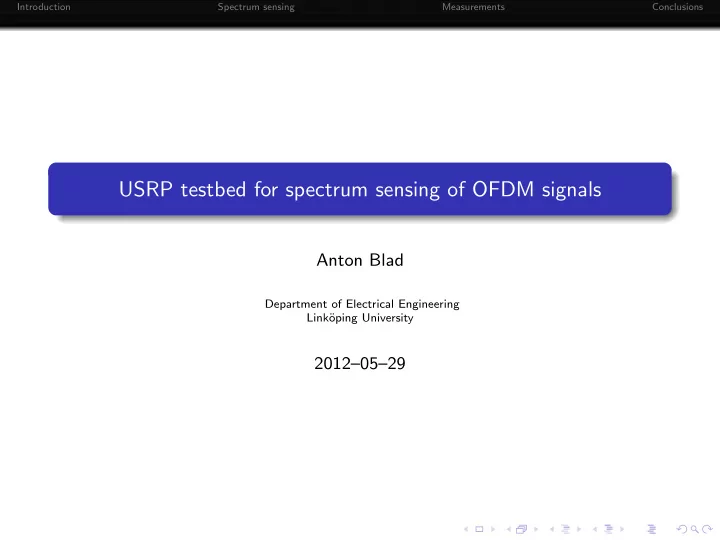

Introduction Spectrum sensing Measurements Conclusions USRP testbed for spectrum sensing of OFDM signals Anton Blad Department of Electrical Engineering Link¨ oping University 2012–05–29
Introduction Spectrum sensing Measurements Conclusions Outline Introduction 1 Spectrum sensing 2 Measurements 3 Conclusions 4
Introduction Spectrum sensing Measurements Conclusions Background Cognitive radio opportunistic use of licensed spectrum by secondary user autonomous units with adaptable radio-system parameters requires ability to detect primary user activity Application: secondary use of TV frequencies TV frequencies often underutilized IEEE 802.22: rural broadband access detection of primary user: spectrum sensing or (national) database Spectrum sensing detection of primary user in licensed spectrum does not require legacy channel to database finer detection granularity (in time and space) Focus of work spectrum sensing of digital TV (OFDM) signals practical evaluation of sensing algorithms single secondary user, idle while sensing
Introduction Spectrum sensing Measurements Conclusions Feature-based signal detection Primary user uses OFDM signal FFT size: N d , cyclic prefix: N c �� �� CP ������ ������ Symbol ��� ��� �� �� CP ������� ������� Symbol ��� ��� �� �� ������ ������ ��� ��� �� �� ������� ������� ��� ��� N c N d Received signal: x ( n ) Define auto-correlation at distance N d : r N d ( n ) = x ( n ) x ∗ ( n + N d ) 20 real(r Nd ) imag(r Nd ) 10 0 −10 0 100 200 300 400 500 600 700
Introduction Spectrum sensing Measurements Conclusions Feature-based signal detection (cont) Noise suppression by averaging over K symbols: R ( n ) = � K − 1 k =0 r N d ( n + k ( N d + N c )) , n = 0 , . . . , N d + N c − 1 200 real(R) imag(R) 100 0 −100 0 100 200 300 400 500 600 700 General description of sensing algorithm Compute metric M based on x ( n ), r N d ( n ) and/or R ( n ) Primary user detected if M > t t threshold calibrated such that P ( M > t ) = P FA (false alarm probability) when primary user not present
Introduction Spectrum sensing Measurements Conclusions Algorithms Averaging N d + N c − 1 � � 1 � � � M = R ( n ) � � � K ( N d + N c ) − 1 � � | x ( n ) | 2 � � n =0 n =0 Sliding window [802.22] � τ + N c − 1 � 1 � � � M = | x ( n ) | 2 max R ( n ) � � � K ( N d + N c ) − 1 � � τ � n = τ � n =0 Generalized likelihood ratio test-based � N c + N d − 1 | R ( n ) | 2 i =0 M = max 2 � � τ 1 � � R ( k ) − � i ∈ S τ R ( i ) + � ∈ S τ | R ( j ) | 2 � � k ∈ S τ N c j / � Energy K ( N d + N c ) − 1 � | x ( n ) | 2 M = n =0
Introduction Spectrum sensing Measurements Conclusions USRP implementation Measurement setup 1 USRP as primary user, 1 USRP as secondary user secondary user is only sensing the spectrum USRP 1 with RFX2400 daughterboards Measurements done in university basement (weak WLAN signals present) Antenna distance: ca 10 meters Spectrum senser data path SNR est senser 1 x ( n ) ACF, energy, ... senser N Receiver SNR estimation SNR range: -30, .. -10 dB: SNR estimation hard SNR estimation algorithm Measure received P noise with transmitter off 1 Measure received P fs with transmitter at full power 2 Pfs − Pnoise 3 Compute SNR 0 dBfs = 10 log 10 Pnoise Determine SNR at A dBfs: SNR = SNR 0 dBfs + A 4
Introduction Spectrum sensing Measurements Conclusions Measurement results Signal bandwidth: 6.4 MHz Calibration for P FA = 0 . 05 0 0 10 10 −1 10 Averaging Averaging P MD Slid. wind. P MD Slid. wind. −1 10 GLRT GLRT Energy Energy −2 10 −2 −3 10 10 −20 −15 −10 −5 0 −20 −15 −10 −5 0 SNR [dB] SNR [dB] FFT: N d = 2048 FFT: N d = 256 Cyclic prefix: N c = 64 Cyclic prefix: N c = 64 Sensing time: 16.9 ms ( K = 64) Sensing time: 2.56 ms ( K = 64)
Introduction Spectrum sensing Measurements Conclusions Metric distribution Theoretical distribution of metrics determined for energy and averaging algorithms Can be used to set calculate threshold theoretically Energy algorithm Averaging algorithm 7 140 4x 10 120 noise 3.5 noise 100 SNR=−10 dB 3 2.5 80 f(x) SNR=−10 dB f(x) 2 60 1.5 40 1 20 0.5 0 0 0.01 0.02 0.03 0.04 0.05 0 1.55 1.6 1.65 1.7 1.75 1.8 1.85 1.9 x x −6 x 10
Introduction Spectrum sensing Measurements Conclusions Conclusions General observations Sliding window and GLRT-based detectors very similar in performance Averaging detector inferior Energy detector superior despite being sensitive to noise estimation WRAN detector similar to GLRT detector Future work Outdoor measurements Performance in presence of interference Measurements with larger FFTs Robustness to noise uncertainty
Recommend
More recommend